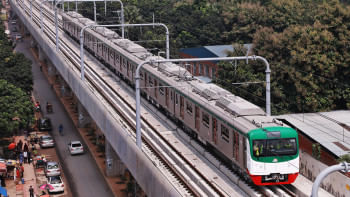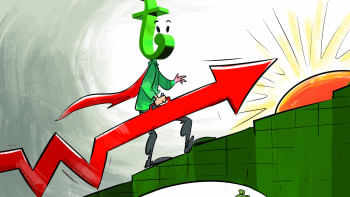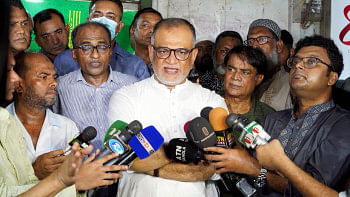A poverty, inequality, and growth puzzle

Some key findings from the Household Income and Expenditure Survey (HIES) 2022, released on April 12, challenges constructing a sensible economic narrative on poverty, inequality, and growth in Bangladesh. Backward calculations of poverty based on the reconstructed 2022 upper and lower poverty lines have not been done yet. It is therefore technically incorrect to compare the 2022 headcount ratios and poverty gap measures with their counterparts in previous surveys.
The poverty trend emerging from valid comparisons with the previous rounds of HIES may or may not be different. We won't know until we know what the comparable numbers on poverty headcounts and gaps are. We hope the Bangladesh Bureau of Statistics (BBS) will finish their unfinished work sooner rather than later. Meanwhile, all we can do is search for the story within the available data, assuming the trends are robust.
Three notable urban-rural differences
First, the incidence and depth of rural and urban poverty tended towards convergence (narrowing differences). The headcount ratio and poverty gap measures improved faster in rural than urban areas. This is most notable in the case of extreme poverty, but it is also true for the headcount ratio based on the upper poverty line. Poverty gap measures, based both on the upper and lower poverty lines, suggest the same pattern. Reduction in depth was faster in rural areas.
Second, trends in relative inequality diverged. The urban Gini coefficient (which measures inequality) increased and the rural decreased. This is true irrespective of whether the Gini is computed from the distribution of income or consumption. Urban income Gini increased 8.2 percent and consumption Gini increased 7.9 percent in 2022 relative to 2016, compared, respectively, with 1.8 percent and 3 percent decline in the rural areas over the same period.
Third, real income and consumption growth were higher in urban locations. Real monthly household income, after deducting the percentage increase in the Consumer Price Index (CPI) from nominal income growth, increased 49.6 percent in urban areas, compared with 48.3 percent increase in rural areas in 2016-22. Growth in the monthly average real household consumption of urban and rural households was 65.4 percent and 50.4 percent, respectively.
An apparent puzzle
These together create a puzzle. Lower income or consumption growth are associated with reduced inequality and faster poverty reduction! Poverty reduction was faster in rural areas where inequality declined, while real income and consumption growth were lower. Poverty reduction in urban areas was slower with a sharp increase in inequality and stronger income and consumption growth. What could possibly explain this phenomenon?
Structural changes can at best be part of the story. This includes almost universal access to electricity in 2022, most notably in the rural areas from 68.9 percent in 2016 to 99.1 percent in 2022. Electricity access in urban locations improved from 94 percent in 2016 to 99.7 percent in 2022. Electricity can directly increase welfare by enabling households to access a variety of services such as food preservation, education, health, and information. Rural households caught up with their urban counterparts on developmental dimensions. However, it begs the question why such large improvements in access to electricity did not show up in stronger rural real income and consumption growth, without which it cannot have a stronger effect on poverty measures.
There is no such discernible rural catch-up on other structural indicators. For instance, improved toilet facilities were reported by 95.3 percent urban households, compared with 90.9 percent rural households. Access to drinking water from tube wells remained unchanged at around 95 percent in rural areas, while access to "supply water" improved from 37.3 percent in 2016 to 56.6 percent in 2022 in urban areas. Households opening a bank account in the past 12 months increased from 7.6 percent in 2016 to 13.4 percent in 2022 in rural areas, compared with 7.3 percent and 15.7 percent, respectively, in urban locations.
Changes in social and demographic indicators are mixed. Male dominance in decision-making remained unchanged at around 87 percent in households that became somewhat larger in size in both urban and rural areas. The literacy rate in rural areas increased from 63.3 percent in 2016 to 70.3 percent in 2022, and in urban areas it increased from 71.6 percent to 82 percent, respectively.
Yes, the rise in the share of industry in GDP raised urbanisation, but employment shifted in the opposite direction. The Labour Force Survey (LFS) 2022 shows that urban share in total employment declined from 27.9 percent in 2016 to 25 percent in 2022. Employment level in industry declined by 2.8 percent, probably in urban-centric large and medium industries. The increased labour force and displaced industrial workers were absorbed by a 30.4 percent increase in agricultural and 12.4 percent increase in services employment – not quite the KC types. A source of increase in inequality in the Kuznets world is the influx of cheap labour from rural to urban areas.
It's not a Kuznets phenomenon
The Kuznets Curve (KC) has gained resonance in the establishment view of the data. Inequality increases in the early stage of economic development, peaks at a mid-income level, and then falls as development proceeds further. Bangladesh is categorised in the early stage of development and, therefore, it must be that KC is operative here.
The evidence on the validity of KC is at best mixed in the HIES data. In the three surveys (2010, 2016 and 2022), urban monthly income per household exceeds rural, and urban Ginis exceed rural Ginis, giving the appearance of a KC. However, the income in rural areas increased in 2022 relative to 2016 while inequality decreased, which disputes KC. Moreover, data do not bear out the standard Kuznets story that the pattern is caused by a dual economy dynamic generated by the switch from agricultural to industrial sector.
Yes, the rise in the share of industry in GDP raised urbanisation, but employment shifted in the opposite direction. The Labour Force Survey (LFS) 2022 shows that urban share in total employment declined from 27.9 percent in 2016 to 25 percent in 2022. Employment level in industry declined by 2.8 percent, probably in urban-centric large and medium industries. The increased labour force and displaced industrial workers were absorbed by a 30.4 percent increase in agricultural and 12.4 percent increase in services employment – not quite the KC types. A source of increase in inequality in the Kuznets world is the influx of cheap labour from rural to urban areas.
Evidence from recent development experiences is similarly weak. Kuznets himself recognised the fragile empirical basis of his grand generalisation, calling it "perhaps 5 percent empirical information and 95 percent speculation, some of it possibly tainted by wishful thinking."
The missing links
What may explain the tripartite disconnect? There are several candidates.
A shift in employment towards rural-centric activities is consistent with a rise in inequality in urban areas, its fall in rural areas, faster rural poverty reduction, and stronger urban income growth. The urban-centric large and medium industrial enterprises grew the fastest. Decreased employment means decreased labour incomes of below-poverty-line urban households, while increased employment in the lowest productivity agriculture suggests greater sharing of incomes among the rural poor. This could have resulted in weaker income growth, decreased inequality, and faster poverty reduction in rural areas relative to urban areas.
A second candidate is Piketty, who hypothesised that inequality increases when the rate of return on capital exceeds the rate of economic growth. When capital grows faster than the economy, the concentration of wealth speeds up along with the concentration in income and consumption.
Perhaps the excess of return on capital over economic growth increased in the urban areas. The HIES 2022 data shows that average household loans to income ratio increased in urban areas and decreased in rural areas during 2016-2022. If the increased loans was concentrated among the privileged urban households, they were probably able to leverage a higher return on capital by hook (investment) or crook (loan defaults) – or both. This could have caused the stronger but more concentrated income and consumption growth and a slower pace of poverty reduction in urban locations.
The dichotomisation of data into rural and urban could be masking important heterogeneities within each. Perhaps the disconnect is the tip of the iceberg of a broader pattern of poverty, inequality, and income growth that transcends the rural-urban duality.
A third candidate, seemingly related to the above, is a sharper digital divide in urban areas. A digital divide exists for groups who lack resources and the capacity to access smartphones, computers, and Wi-Fi. The new digital opportunities can only be accessed by those who have capital and digital literacy. Not surprisingly, therefore, the digital divide is greater in rural areas. The BBS Survey on ICT Use and Access by Individuals and Households 2022 shows that the proportion of households with access to the internet is 63.4 percent in urban areas, compared with 29.7 percent in rural areas.
However, variations in digital access between urban and rural socioeconomic groups matter. Since 68.5 percent of the total population live in rural areas (Population Census 2022), the 29.7 percent rural internet users constitute 20 percent of the total population, while the 63.4 percent urban internet users also constitute 20 percent of the total population. The digital divide taking quality into account – lower-performance computers, lower-speed wireless connections, lower-priced internet connections, and limited access to subscription-based content – is probably more pronounced between different age groups, genders, occupations, and incomes in urban than in rural households.
Last but not necessarily the least, differences in migration patterns – overseas in particular – may be part of the story. Overseas migration rates far exceeded internal migration (from one district to another). Overseas migration reported by rural households (over nine percent) exceeded the same reported by urban households (6.3 percent) in all three surveys. Increase in the income of families left behind can significantly reduce the income Gini over time, since most rural overseas migrants are unskilled workers, many of whom are also from vulnerable poor households.
In these cases, there is no direct impact on the poverty headcount ratio. Also note that the difference in growth of average monthly rural and urban household incomes turned from positive (one percentage point) between 2010 and 2016 to negative (1.5 percentage point) between 2016 and 2022. This happened despite persistently higher overseas migration from rural households, thus showing the limits of its power in explaining the puzzle.
Full data disclosure needed
The dichotomisation of data into rural and urban could be masking important heterogeneities within each. Perhaps the disconnect is the tip of the iceberg of a broader pattern of poverty, inequality, and income growth that transcends the rural-urban duality.
The completion of work on the HIES 2022 and LFS 2022 is a very significant data development, from which extremely useful information about the dynamics of poverty, inequality, employment, and growth can be extracted, leveraging Census 2022 and the annual national accounts data as well. The BBS can maximise the public good from their work by publishing detailed tables and providing access to the unit records sooner than later.
Dr Zahid Hussain is former lead economist of the World Bank's Dhaka office.

 For all latest news, follow The Daily Star's Google News channel.
For all latest news, follow The Daily Star's Google News channel. 











Comments